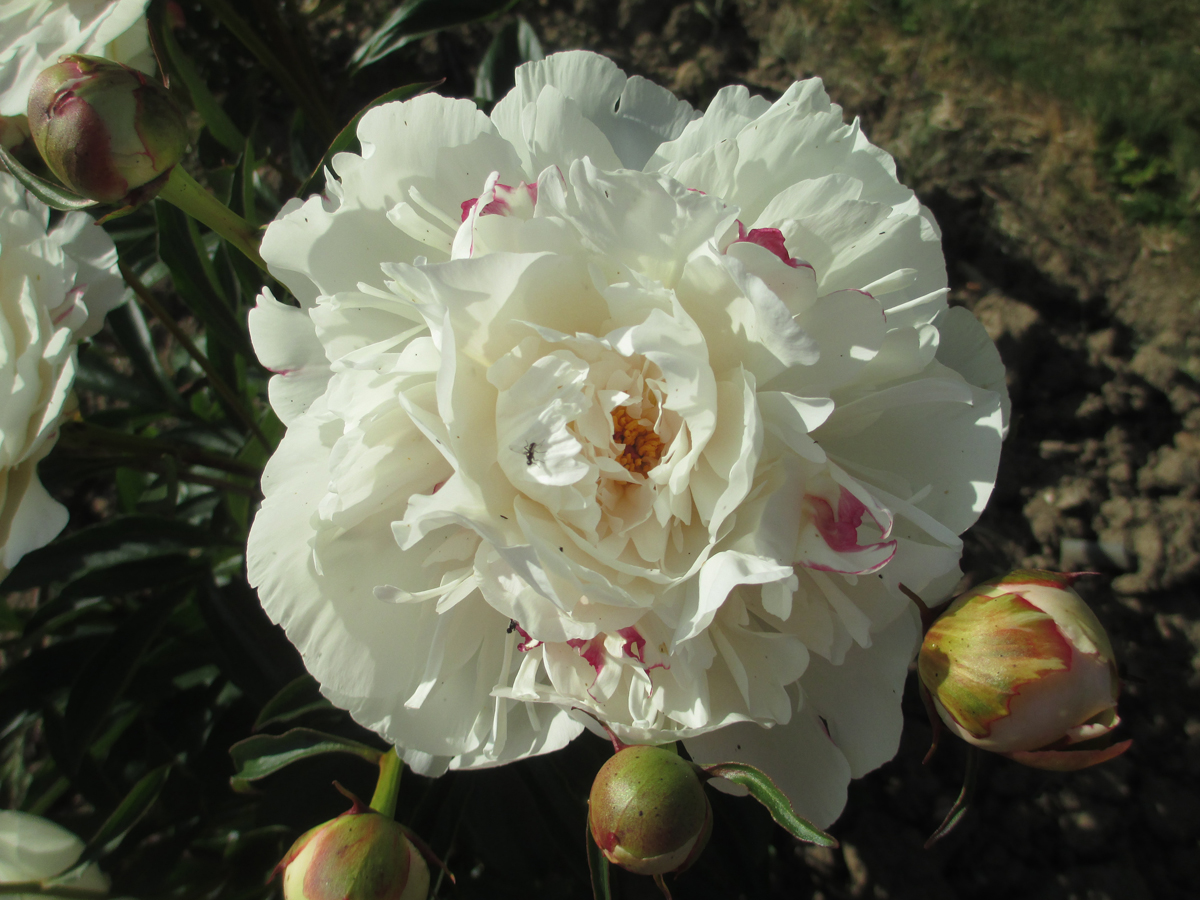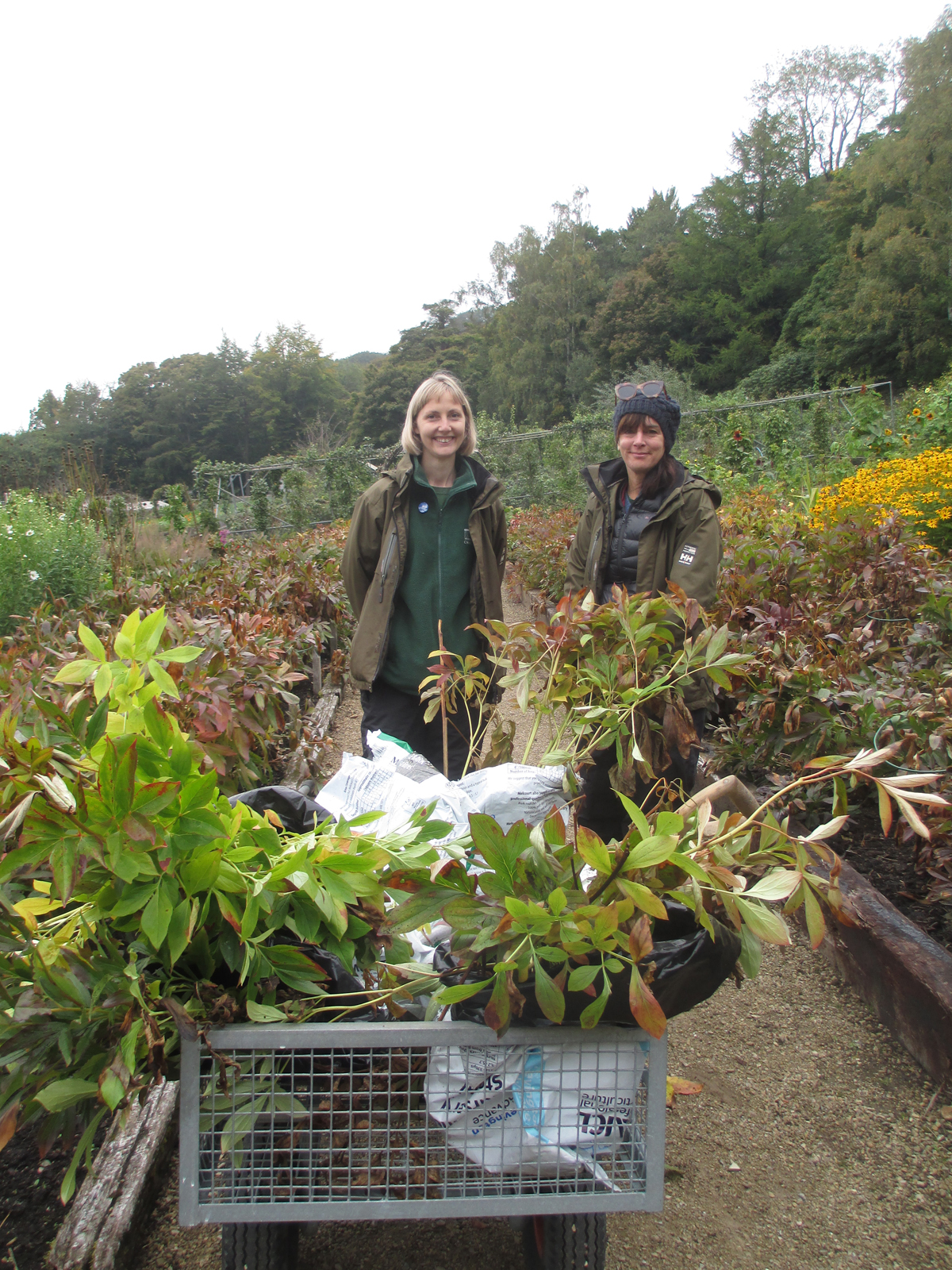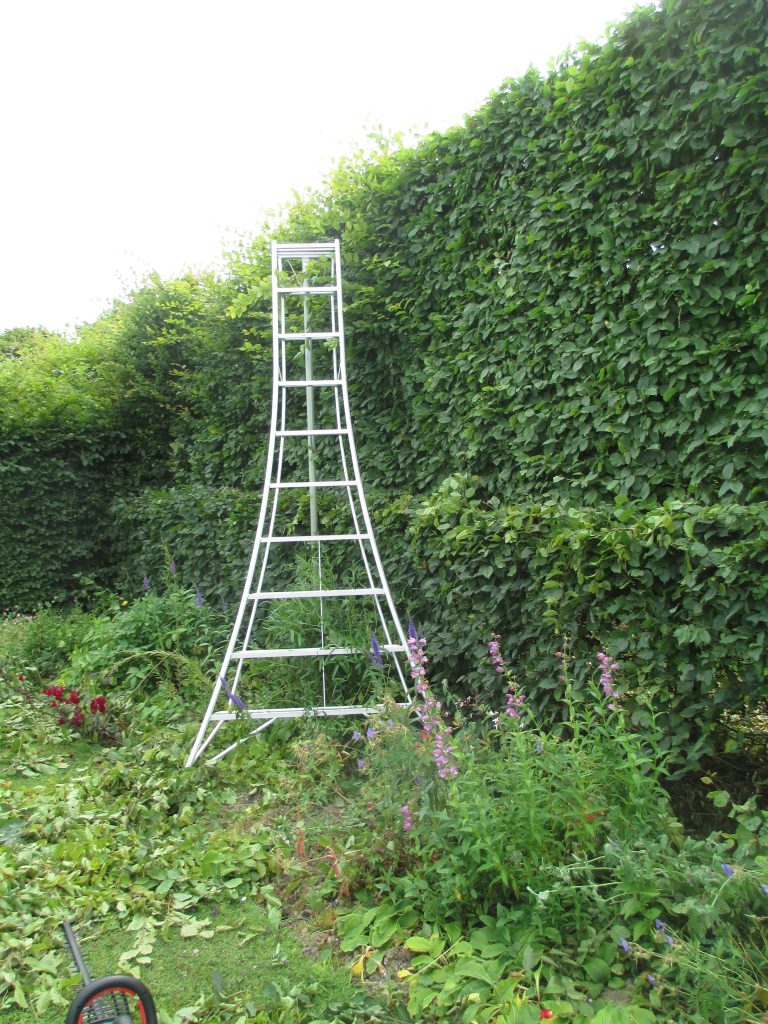The last day of January already! It has been a very wet start to the year so less has been achieved than I would like. A peony bed has been extended ready for more planting and some heavy duty pruning has helped tidy up the courtyard. Fuschia ‘Hawkshead’ is a lovely dainty white hardy fuschia. It is now about seven feet tall and taking up considerable space. Cutting into branches that were easily four inches diameter I could only muse that it seems like yesterday that I planted it! I have also removed a Holboellia and a lot of ivy from a stone wall. These are about the only jobs I can do with the ground so wet. I should have kept on top of the ivy which has now become a big job and the Holboellia had outgrown its welcome several years ago already. Now my problem is that I have a huge sodden bonfire heap too wet to light! But the snowdrops are in flower (this one is ‘Bess’) and the first daffodils coming out. More than anything daffodils raise my spirits and turn my thoughts to Spring.
Category Archives: Uncategorized
October 2020
After a wonderful summer of peonies that have flowered better than ever, the garden is moving into Autumn. Hard work has been underway this year weeding the flower beds and cutting the hedges ; it has been possible to get into some of the ignored corners which now look much better. A thicket of winter honeysuckle has been cleared giving the alba roses that were being elbowed out a chance to flourish again. Jobs like that always prove to be more work than expected but its very satisfying when its done. Now I need to get on quickly with jobs like mulching the beds with well-rotted manure because already the ground is so wet after recent rain that repeated journeys with the wheel barrow turn it to a quagmire.
I have had some success in my search for Kelway’s herbaceous peonies, although it is very sad how many seem to be lost. I have just returned from a round Britain tour with my spade in the car collecting some that have been kept safe in gardens. People are very, very kind. A huge thank you to Michelle Cain, head gardener at NT Sissinghurst, Amy at NT Anglesey Abbey, Sophie and Sarah at Chatsworth and all the private gardeners who have given me plants. Some of the peonies need to flower so I can verify their identity; lockdown put paid to my intention to go and see them in June. But my fingers are crossed that they will prove to be correct. There must also be a very special thank you to Prague Botanic Gardens. This is a very conservation minded institution staffed by very kind people. Definitely a place to visit if you ever get the chance. I am a step closer to my aim of creating a National Collection of herbaceous peonies bred by Kelways but the hunt goes on!
June 29 2020
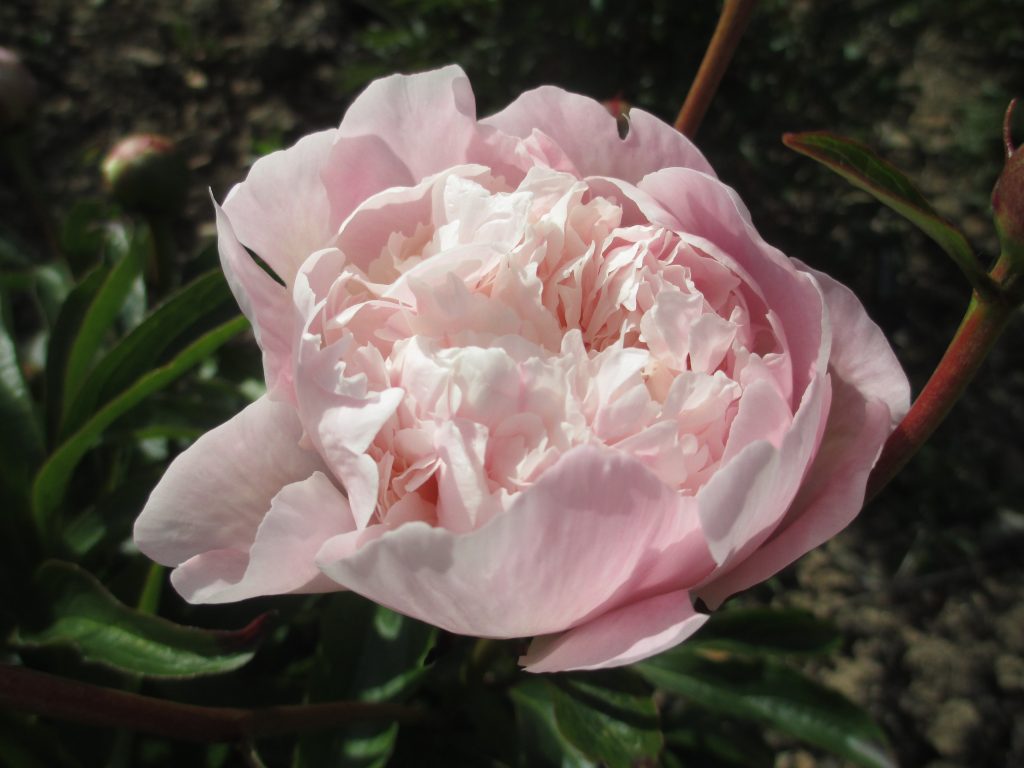
I suppose I keep saying this – possibly every year – but what a strange year for weather. After months of heat and bone dry weather the rain came in the nick of time. The hot weather brought the peonies on extremely early. My first started to flower on May 11th, that is two if not three weeks earlier than normal. The flowers on both the roses and peonies have been wonderful. The peonies stood up well and even the singles lasted very well. I had about a six week season for the peonies this year. The bees loved it. It was difficult to take a photograph of a peony without a bee in the picture. Different peonies caught my attention this year: ‘Germaine Bigot’ with huge flowers – I measured over six and a half inches one day and it got bigger over the next few days, ‘Mme Jules Dessert’ looking really lovely and ‘Mme de Galhau’ with a nice shaped flower that stood up well. It was a real relief when the rain came even though it came in torrents! The peonies newly planted last autumn were in real need of it, and the ground that had turned to concrete has softened up enough to let me get back to weeding!
June 2020
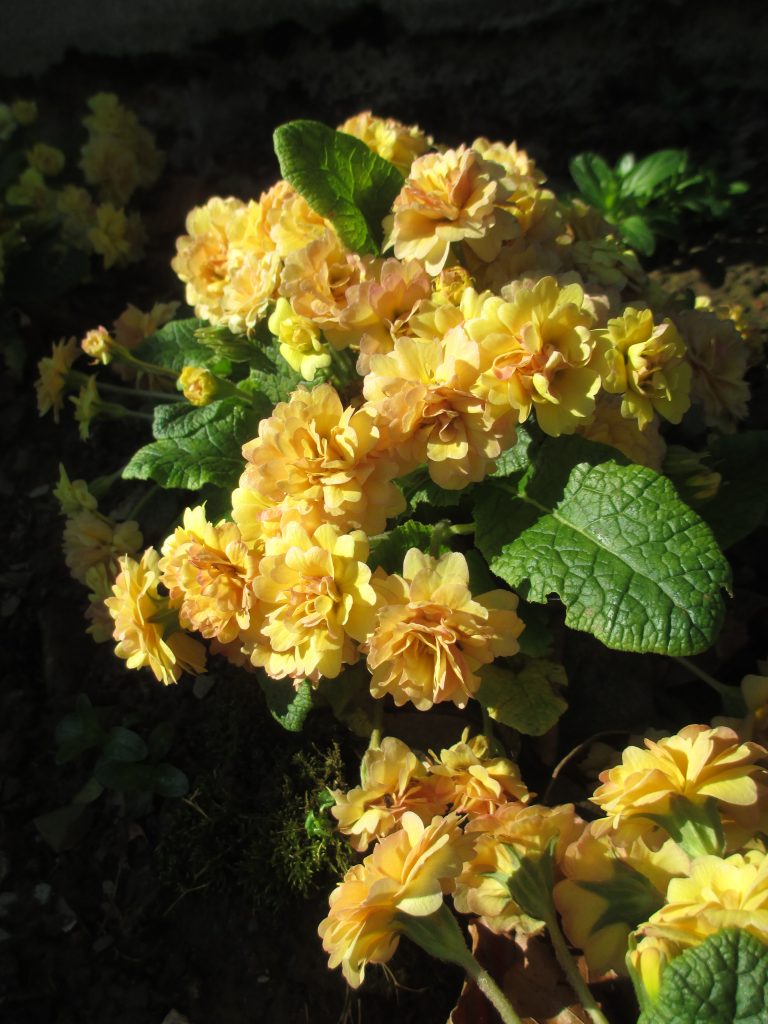
We have had an amazing few months of weather: clear blue skies and sunshine. The swallows came back on Good Friday and around the same time I was seeing orange tip butterflies – truly a sign of Spring! The last of the double primroses finished off the season in style. Here ‘Sunshine Suzy’ living up to her name.The weather allowed a great deal of work to be done. After such an incredibly wet winter there has been a lot to do too. Edges to flower beds have just melted with the weight of the rain, and weeds had taken advantage. So while circumstances kept us all at home I have been able to catch up a lot on work. It has also been an opportunity to think about what works well in the garden and what I should just change. So easy to keep looking at something without really assessing it! One thing I have noticed this year is a gap in flowers in the garden once the daffodils and double primroses are over. In May the peonies and irises start, as do the roses. But there is an in-between period that I need to think about. I am being very tempted by some flowering trees and shrubs but I don’t think they will help with “the gap”! I have made a note for more tulips, more bulbs generally. Spring is such a wonderful time of year – you can’t have enough of it! Things like viburnum have such a lovely fresh look to go with the gloriously bright new growth of grass. The Horse Chestnut tree is buzzing with bees – all just wonderful!
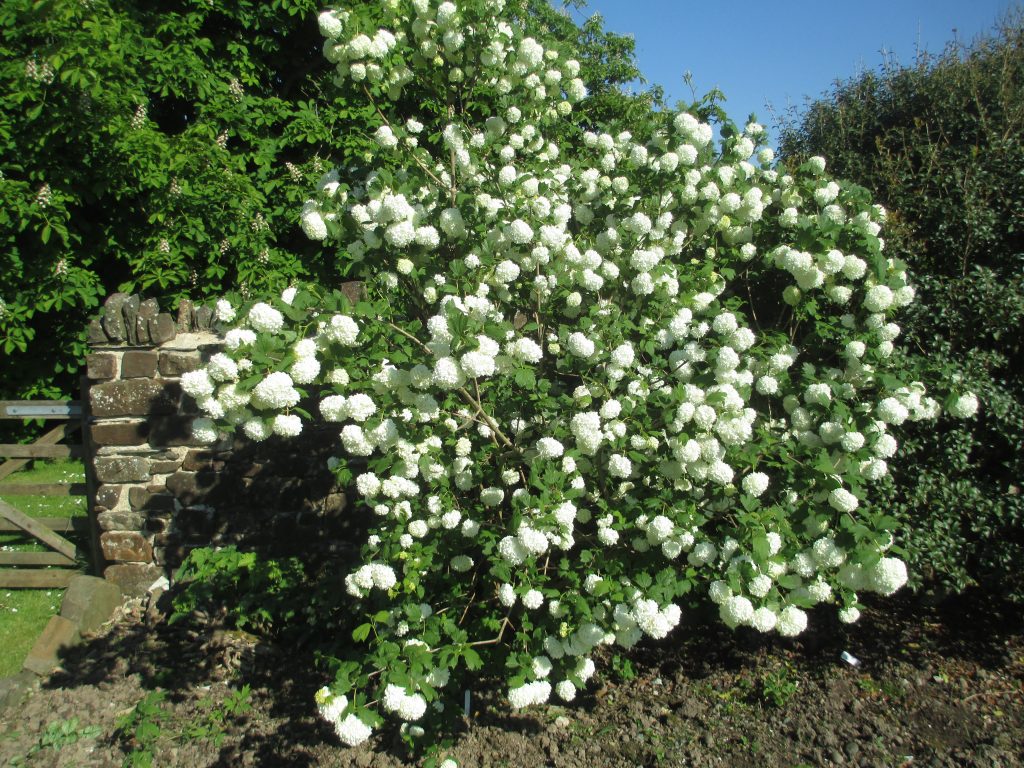
April 8th 2020
There is no more beautiful flower than a wild primrose – of that I am quite certain! This year they have been particularly good. They started in flower in the lanes very early in the year when the weather was miserable and everything else was dull and dismal, except for the fresh flowers of the primroses. And now as the greenery of Spring is really getting going the wild primroses are still in flower. In the garden the double primroses tend to start a little later than the wild primroses and as we move into April they are looking superb.
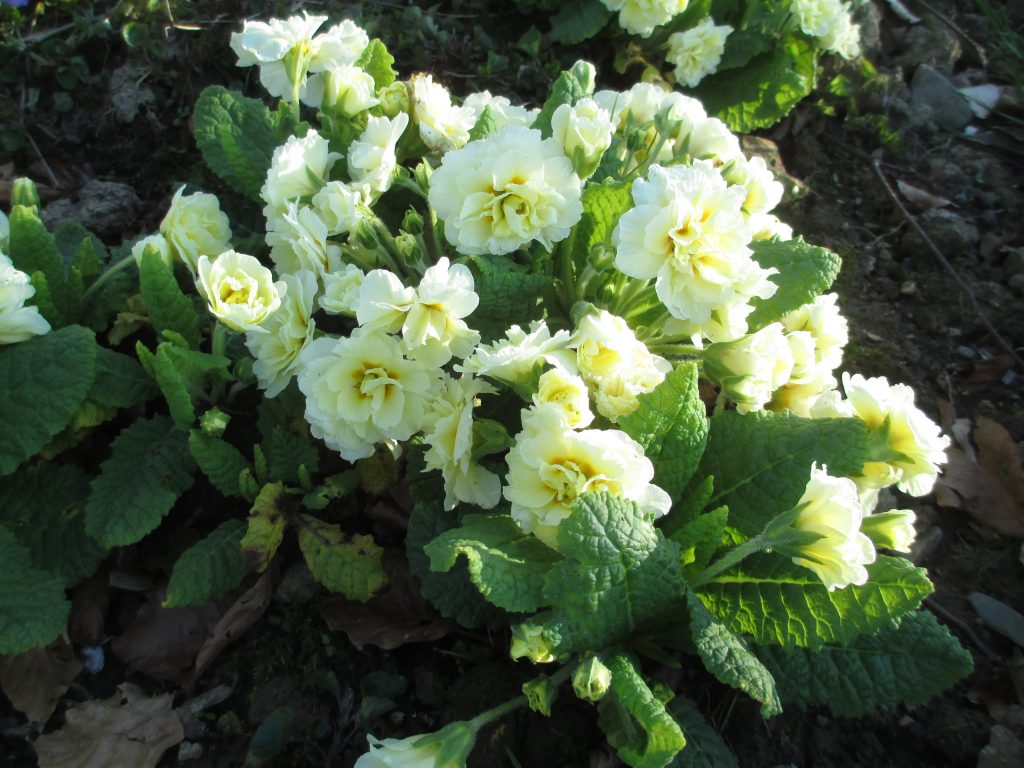
I have been finding myself thinking about which are the best and most reliable – but to be honest the list is long. It is key to have the right conditions, of course. They do need damp ground – no lack of that here! But with the right conditions they really are superb plants. ‘Marianne Davey’, an old Barnhaven variety is an extremely good plant with all the freshness of Spring.
For long flowering there are several excellent choices – ‘Sunshine Suzie’ who starts flowering in December and goes on and on. A really bright yellow flower that fades into tinges of apricot; she cheers up the Winter months.
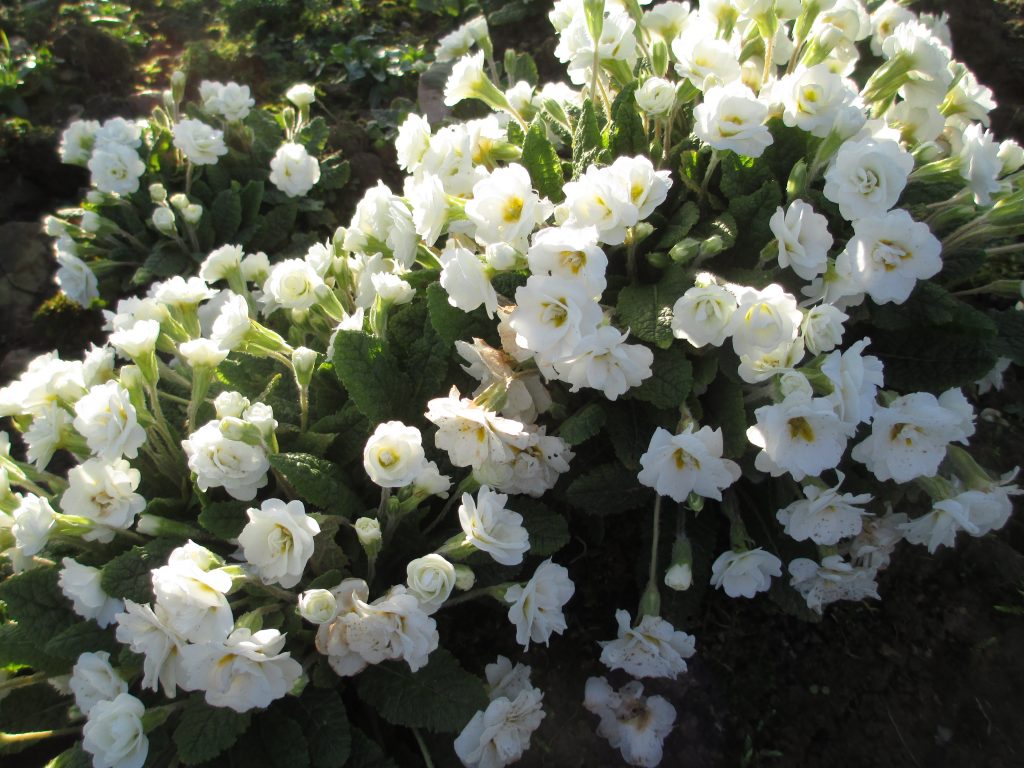
‘Petticoat’, a white double. The flower is smallish but she flowers and flowers. I have used ‘Petticoat’ this year to edge flower bed beside a path. The bed has a lot of the snowdrop ‘S. Arnott’ and I thought this would be a good addition.

Another long-flowering and beautiful double primrose is ‘Easter Bonnet’. Similar in shade to the very old and lovely ‘Quakers’ Bonnet’, this has far more flowers and keeps up its show for months on end.
March 2020
After an extremely wet winter the garden is still too wet to get any work done properly. The grass is very long and lush but the ground still too wet to walk on in areas. None the less Spring is underway and plants are growing. The daffodils have been a joy. I must remember to get more early varieties however. On dismal days they lift the mood.
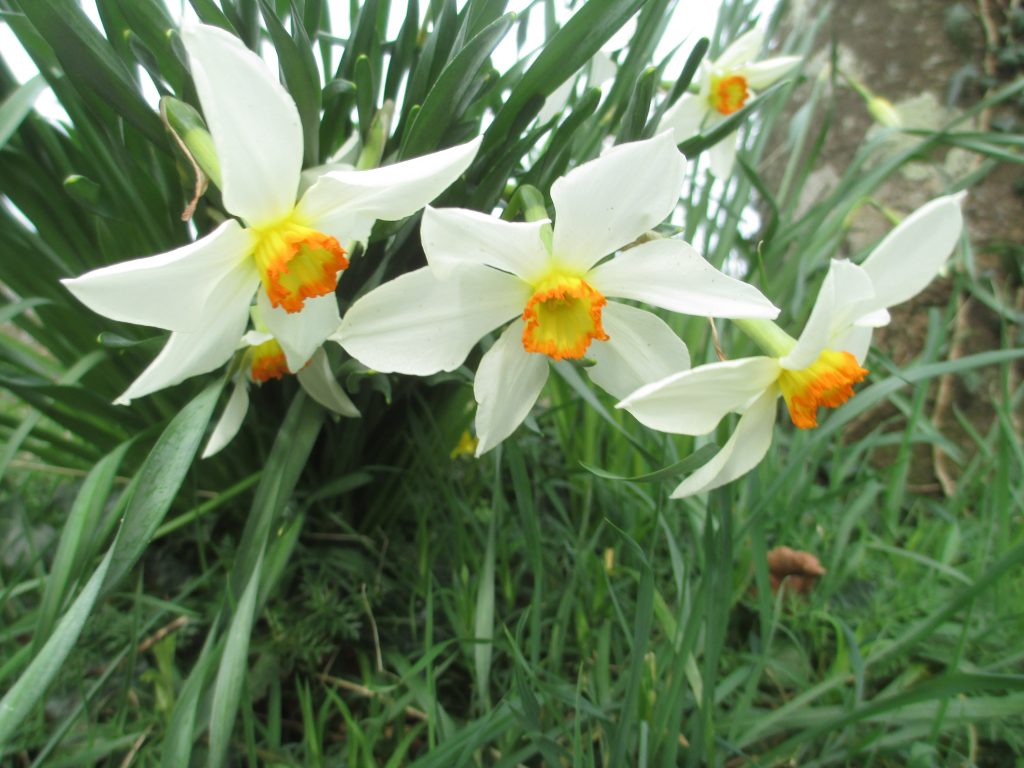
When I moved here I inherited a lot of daffodils growing on my hedge (this is Cornwall – a hedge is an earth bank here). Slowly I am managing to identify some of the varieties. They all seem to be pre 1920. The small cup varieties like this one I find very difficult to identify. The differences seem to be very small. However I count myself very lucky since there is a huge range on the hedge. Many very delicate and pretty. And they flower over a very long season starting with the very old ‘Van Sion’ and ‘Glowing Phoenix’ and ending with the small cup varieties.
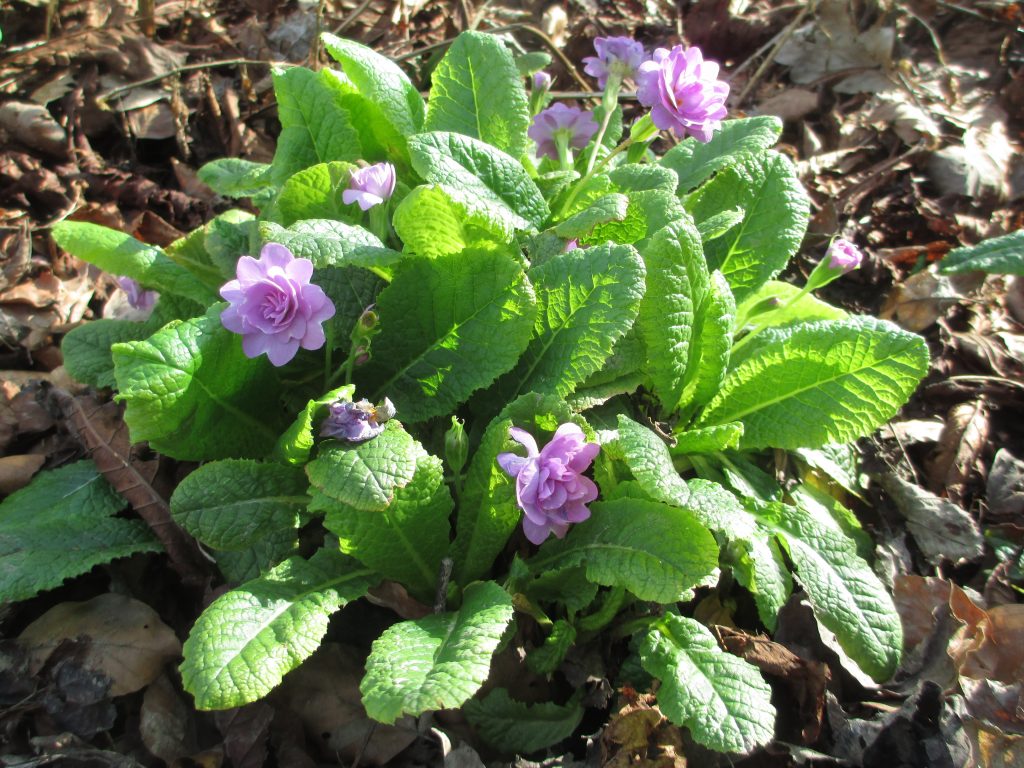
Now in late March my double primroses are really starting to flower well. This is an old variety ‘Quaker’s Bonnet’ – the old one’s don’t tend to have so many flowers as the modern varieties but they have a lot more charm and I treasure them. I have several newly bred double primroses this year. They are all sold bred by David Kerley famous for his trademark Belarina range of double primroses. I think many of them are extremely good. I have always loved ‘Belarina Cream’ which has a lovely fresh look to it and is trouble free in cultivation. Another favourite of mine is ‘Delft Blue’. David says it is too leafy because he is aiming for wow-factor in the garden centres. In fact it makes it much easier to place in the garden.
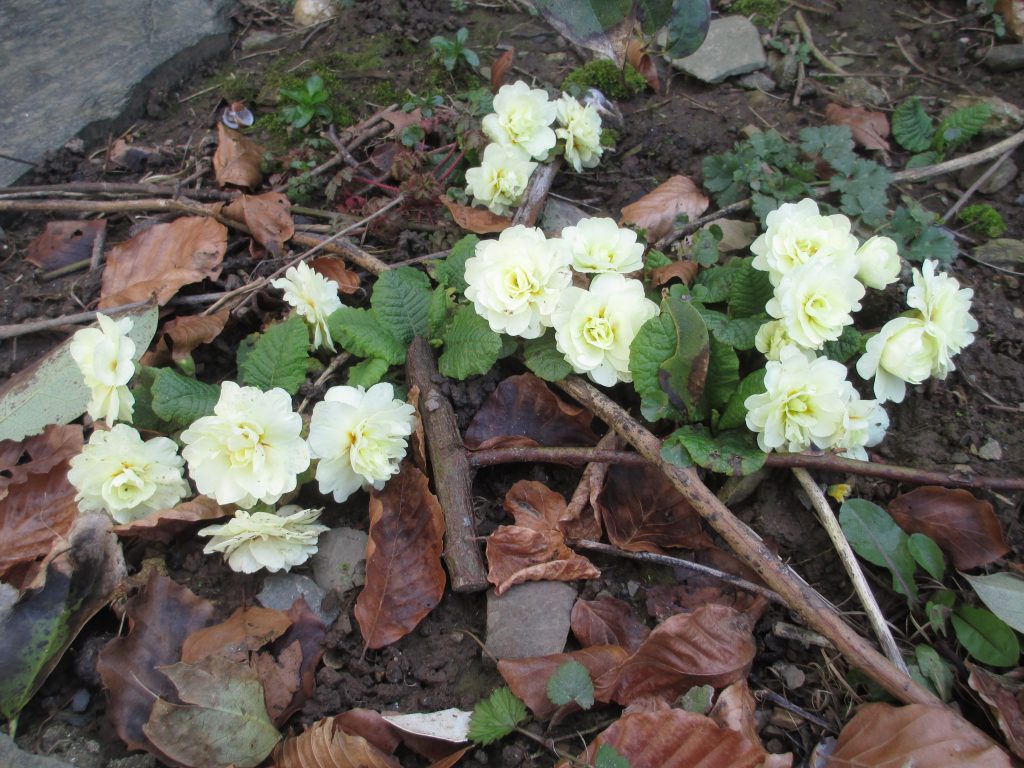
Amongst David’s recent releases have been ‘Blue Champion’ and ‘Baltic Blue’. ‘Baltic Blue’ is a very nice shade of blue. I think all the blue double primroses are lovely – and I do have quite a few different varieties – so I am looking forward to seeing how well this one does.
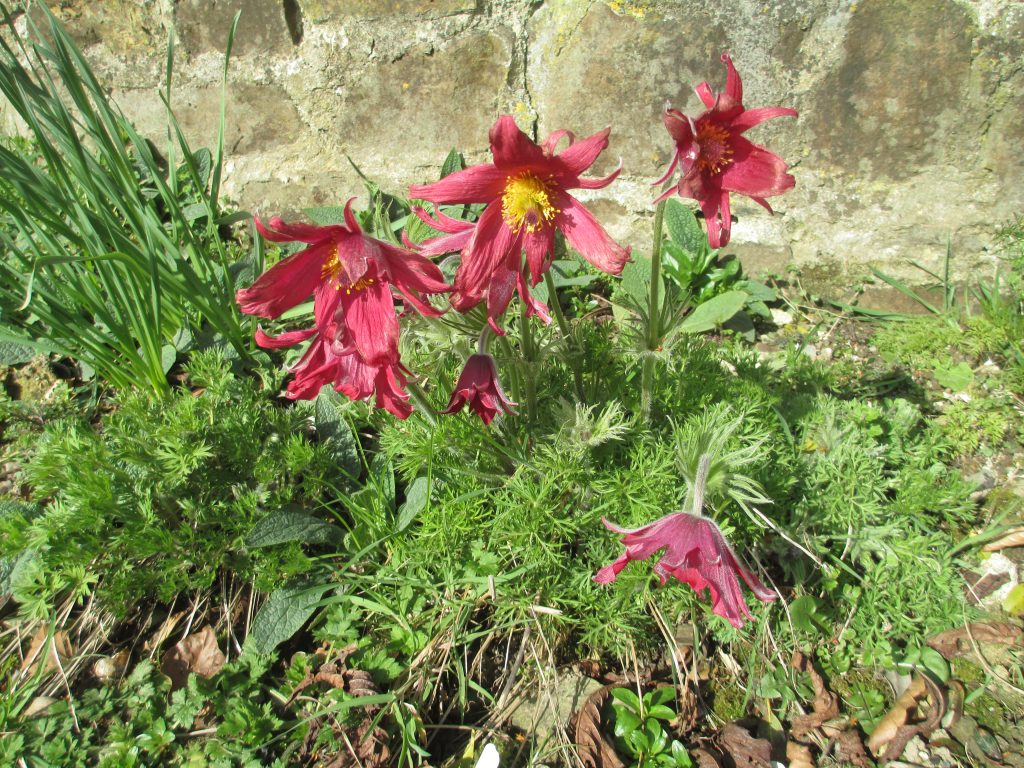
There is so much going on in the garden and I tend to spend time enjoying it (or working in it) and forget about adding to this but I will try harder to share photos this year.
July 2019
Glad to say the bulk of my ladderwork is finished. I love the structure of the pleached hornbeam and garden rooms but it is a huge job to do the main cut of the year. Last year with the hot weather I came in every day with dreadful headaches. This year although it has been another dry summer so far we have not had the extreme heat and there have been enough overcast days to be able to get the work done in reasonable comfort. And this year I have paced myself! Every year I bless Jake Hobson for setting up his company Niwaki. I now do all the work using his ladders. Being so lightweight makes the work much easier, and their manoeuvrability is wonderful. The pleached hornbeam backs onto flower beds and I can get the ladders in without too much damage to plants.
It is the point in the year when different plant groups come to the fore. I have a lot of sanguisorba now. They are looking lovely. It is proving a very good year for penstemon. Last year I took one from my Mother’s garden. Might be the one called ‘Margery Fish’ but I am not sure. It has picked up the colours of Clematis ‘Crystal Fountain’ very nicely and is now teaming itself with a deeper violet-purple penstemon. The astilbe I have been getting from Marwood Hill are also doing well. The lily experiment has proved a success – they have come back again and are looking beautiful. So all in all not a bad year for the garden. Yes, its dry but not so bad as last year. Thank goodness!
Much hard work is under way creating new beds for peonies. Two hundred foot of box hedging has been removed. Now the soil needs improving with manure, and the edges and a new path needs to be made. There is a lot of hard work that goes into creating a garden!
January 2019
A tough year for the garden last year. A very wet winter here. Then two bouts of snow, although nothing like as bad as it was for the rest of the country, and the cold Beast from the East gale which reached even this far west. Then months without rain through the summer. It is very hard for plants to be expected to cope with two such extremes. Primroses did survive the drought although they became very woody and have all needed dividing and rejuvenation. Cowslips interestingly didn’t seem to worry at all about the conditions and did very well.
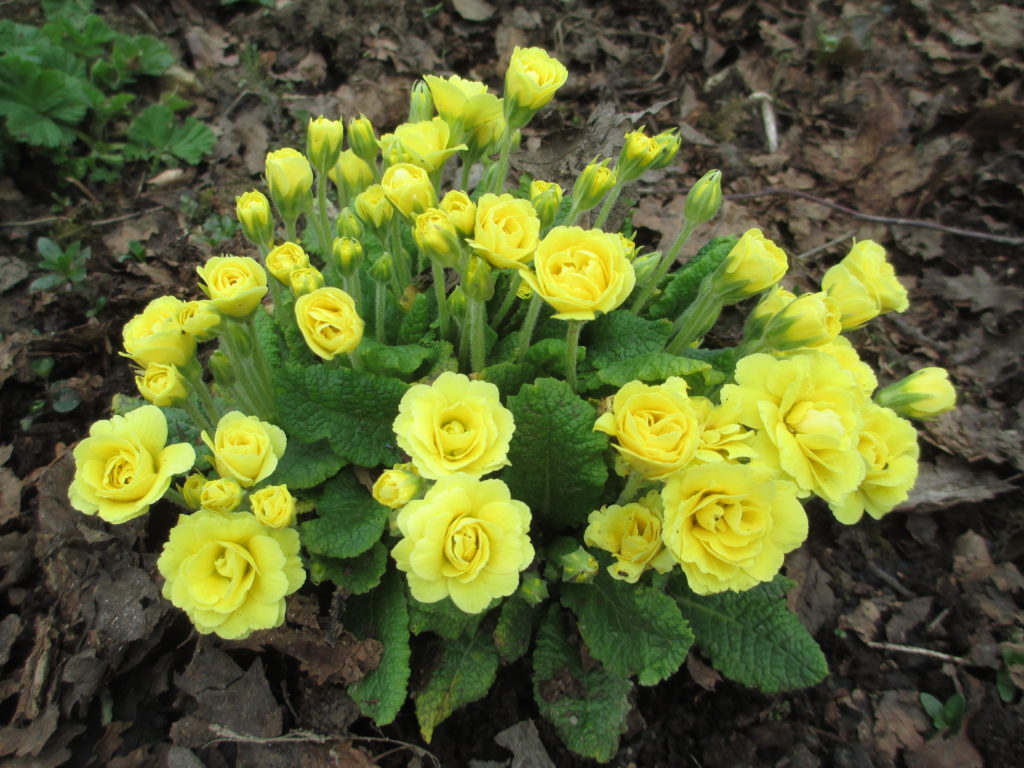
The primroses flowered before the dry conditions set in and looked lovely. By the end of the summer however they had been badly set back and this year I shall be back to building numbers up again.
The heat in late June/early July caused me to stop trimming my box bushes and in particular the box parterre because newly cut leaves were getting scorched. This has meant some radical cutting back is going on now.
Some interesting things did happen in the garden however. After years of trying to get lily of the valley to establish in two different gardens, suddenly is seems I have success – but with the pink version not the normal white ones!
Meanwhile another corner of the garden is being brought in with something of a woodland feel; there are so many lovely shade and woodland plants to try.
A visit to the excellent Cedric Morris exhibition at the Garden Museum has inspired a swathe of the shrub walk. The mood in a painting of Benton End by Esther Grainger has led me to try the same sort of deep red planting with just touches of yellow and blue to lift it. Cedric had his blue meconopsis – I shall need to try other plants I think but the general feel is something to aim for.

The peonies are taking more space every year as I find more varieties to add to my peony beds. They are a delight from the first emergent growth in the depth of winter through to the autumn foliage. Early June is wonderful with new blooms to inspect every morning. This was my first variety into flower in 2018.
Now in January a walk around the garden shows hellebores looking superb. The recently released Barnhaven double primrose ‘Pink Star’ combines very nicely with hellebores and is proving a robust plant for me. Hamamelis ‘Pallida’ has been in flower for sometime and at its feet a single yellow primula with a polyanthus stem ‘June Blake’ has been in flower for even longer. It isn’t a very exciting flower, which is a pity since June and her lovely garden in Ireland deserve something more interesting, but it has been flowering continuously from late autumn which is something in its favour. Hamamelis ‘Diane’ always disappoints me since the red flowers don’t show up well and I often fail to notice when it comes into flower. I have Primula ‘Alan Robb’ planted around it. This is a double primrose I have thought to be not so strong in the past, but last summer strangely seemed to suit it and it is flourishing now. I thought its apricot orange flowers would go well with the hamamelis, and they do, or they would if the birds would stop pecking them!
November 2017
Autumnal gales are upon us and blowing the last leaves off the trees. This year the lovely flame-like scarlet show of my Stewartia was over so quickly and many of the trees also lost their leaves quickly in the storms. The Liquidamber ‘Slender Silhouette’ is the exception and still looks fantastic. The foliage of herbaceous plants like hydrangea have been much better value. The quercifolia still has good red leaves, ‘Sanguine Merveille’ beautiful purple, and my new acquisition ‘Santiago’ a super scarlet. Even something like Penstemon ovatus is looking good with deep red leaves.
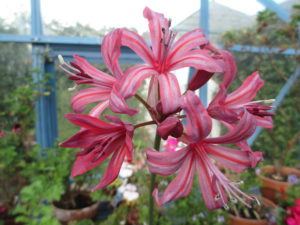 Nerines have been good in the greenhouse. I am building up some nice big pots of various sarniensis varieties. Even in late November there are some good flowers open. ‘Audrey Clarke’ is looking especially striking with four good flowering stems in one pot.
Nerines have been good in the greenhouse. I am building up some nice big pots of various sarniensis varieties. Even in late November there are some good flowers open. ‘Audrey Clarke’ is looking especially striking with four good flowering stems in one pot.
The early double primroses ‘Easter Bonnet’, ‘Sunshine Suzie’ and ‘Miel’ are flowering away with gusto adding some real colour to the garden. It was such a pleasure to be weeding the new big primrose beds this year, and work in the sunshine dividing the primrose plants with the burnt sugar scent of the Cercidiphyllum ‘Rotsfuchs’ to tease me. Malcolm Pharoah, the National Collection holder of Astilbe, gave me some lovely astilbes this year and they too have had extremely good autumn foliage colour. He has really opened my eyes to these plants. There is so much more of a range than I had realised. I have planted the charming dwarf astilbe ‘Willie Buchanan’ as something of a ground cover. The ‘Isa Hall’ Malcolm gave me was a delight with delicate gracefully-arching flowers and then stunning red shades to the leaves in the autumn. So now I am branching out and have planted more varieties and am especially looking forward to seeing how some of the very tall ones do.
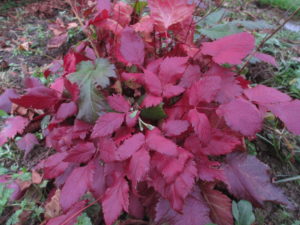
Astilbe ‘Isa Hall’ autumn foliage
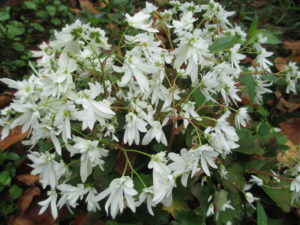
One of the Saxifages in flower
The other delight this year has been the Saxifraga fortunei. they are still flowering away with super mounds of frothy flowers; what a difference they make to shady woodland spots in the autumn. I hope the frosts hold off so their show continues. But what a strange year – the hellebores started flowering in August and most of them have flowers already, and not just the odd flower, they are in full bloom. Violets were in flower in September and the wild primroses in the lawn were making mowing tricky in October. My first snowdrop ‘Faringdon Double’ opened on November 20th. ‘Mrs McNamara’ is set to be the next to flower.
Now I must work fast. The peony beds have been weeded and manure spread but the primroses are waiting for their generous dollops of well-rotted manure. I need to do this before the ground gets too wet to be able to get wheelbarrows around. Then it is the planning for next year. I have many ideas about plants to add to the shrub walk. The shrubs are finding their feet and starting to look good. The Clethra and Styrax are really pleasing. I was very sad in the summer when the Pterostyrax hispida snapped on a day that wasn’t even very windy. It has been tidied back to a good bud and I hope it will overcome this setback. Now with the shrubs establishing well I can spend the winter thinking about plants to tuck in around them.
July 2017
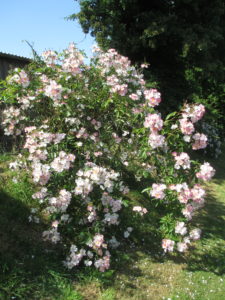 Trying so hard this year to keep on top of annual weeds in the hope that I can reduce future crops! Maybe it will help, maybe it is wishful thinking. I think that there definitely is a correlation between how much work I have put in and how much more easy it is to do the work now. If I think back ten years when I was starting from scratch with a bare field used to cows, I know I don’t have the energy now to do the work I did then.
Trying so hard this year to keep on top of annual weeds in the hope that I can reduce future crops! Maybe it will help, maybe it is wishful thinking. I think that there definitely is a correlation between how much work I have put in and how much more easy it is to do the work now. If I think back ten years when I was starting from scratch with a bare field used to cows, I know I don’t have the energy now to do the work I did then.
Weather this year has been favourable, so I have been able to get on quite well. I am starting to become more ruthless. I should have done this long ago. Fruit trees that haven’t taken properly have gone on the bonfire. I thought I would feel bad but actually I really don’t notice their absence – except to think how much better it looks! Some box that was struggling because of the wet ground has met the same fate, and more will follow. 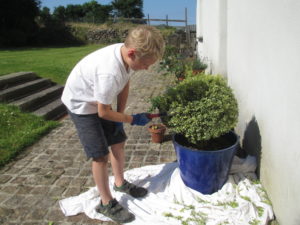 On the box front, Callum, my young neighbour comes to do some work in the garden most weeks. He is very good at trimming things – edges of flower beds, old leaves from phormium plants, that sort of thing. Recently I gave him a box ball to prune. His first effort ever to do this and he took to it like a duck to water. I foresee a future topiarist. Jake Hobson, look to your laurels! Unintentional pun there, sorry!
On the box front, Callum, my young neighbour comes to do some work in the garden most weeks. He is very good at trimming things – edges of flower beds, old leaves from phormium plants, that sort of thing. Recently I gave him a box ball to prune. His first effort ever to do this and he took to it like a duck to water. I foresee a future topiarist. Jake Hobson, look to your laurels! Unintentional pun there, sorry!
I am going to give Callum some plants of his own to work on from scratch and see how creative he can be with them.  It is certainly interesting to watch Callum at work. Children don’t have the worries we have when we get older – he sets to with gusto. I keep reminding him “think twice, cut once”, but actually he seems to have an instinctive feel for it. One day he will cut off a bit and wish he hadn’t, but so far so good! On the left you can see him next to the finished item on his first effort. Top marks!
It is certainly interesting to watch Callum at work. Children don’t have the worries we have when we get older – he sets to with gusto. I keep reminding him “think twice, cut once”, but actually he seems to have an instinctive feel for it. One day he will cut off a bit and wish he hadn’t, but so far so good! On the left you can see him next to the finished item on his first effort. Top marks!
